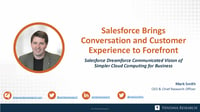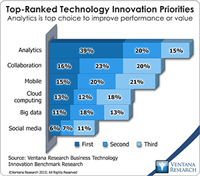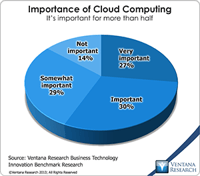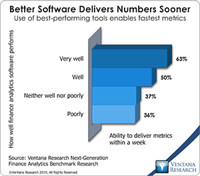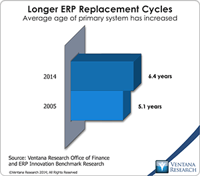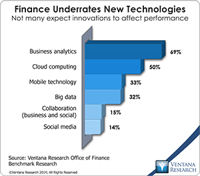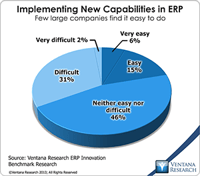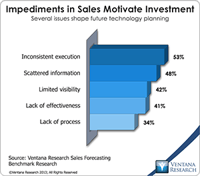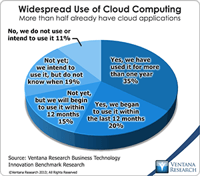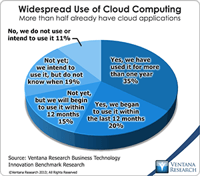Dreamforce has become the largest enterprise software event for businesses in the United States, and it is evident why when looking at it this year. With over 170,000 business and IT professionals attending, Salesforce came to show off upcoming product announcements and innovations. This year's biggest focus was on Einstein Voice (a personalized and intelligent conversational assistant), integration with other platforms, and Salesforce Customer 360. The last of these is the start of an answer...
Read More
Topics:
Salesforce.com,
Customer Experience,
Machine Learning,
Marketing,
Voice of the Customer,
CRM,
Dreamforce,
Sales Performance Management,
SPM,
Digital Technology,
Digital Marketing,
Robotic Process Automation,
AI,
natural language processing
Financial management software provider Intacct recently held its seventh annual user conference. In addition to a long list of enhancements in current and upcoming product releases, the company used the occasion to announce Intacct Collaborate, a capability built into its software that enables finance and accounting organizations to work together to answer questions or resolve issues while performing a process. Our benchmark research shows that collaboration ranks second in importance behind...
Read More
Topics:
Performance Management,
Sales Performance,
Salesforce.com,
ERP,
Human Capital Management,
NetSuite,
Office of Finance,
Reporting,
cloud ERP,
Analytics,
Business Analytics,
Business Collaboration,
Business Performance,
Chatter,
Cloud Computing,
Collaboration,
Dashboards,
Financial Performance,
FinancialForce,
Intacct
At this year's Dreamforce more than 140,000 people gathered in San Francisco to share the excitement about the use of technology for business. Salesforce.com’s annual conference has reached megashow status, which is a mixed blessing: Dreamforce remains social in its design, but it has become impersonal due to its size. In any case Salesforce had plenty to show off. The company has continued to enhance its cloud-based business applications for sales and customer service, and in the last year it...
Read More
Topics:
Sales,
Sales Performance,
Salesforce.com,
Operational Performance,
Analytics,
Business Analytics,
Business Intelligence,
Business Performance,
Customer & Contact Center
Read More
Topics:
Microsoft,
Mobile,
SaaS,
Sales,
Sales Performance,
Salesforce.com,
Supply Chain Performance,
ERP,
HCM,
Human Capital,
Office of Finance,
Dynamics AX,
Dynamics GP,
Dynamics NAV Dynamics SL,
Kenandy,
PSA,
Sage Software,
Unit4,
Operational Performance,
Analytics,
Business Analytics,
Business Collaboration,
Business Performance,
Cloud Computing,
Collaboration,
Customer & Contact Center,
Financial Performance,
Workforce Performance,
CFO,
FinancialForce,
HR,
Infor,
Workday,
HANA,
Plex,
Professional Services Automation
Like most vendors of on-premises ERP and financial management software, in moving to the cloud Oracle has focused on developing for existing and potential customers the option of multitenant software as a service (SaaS). (I’m using the term “ERP” in its most expansive sense, to include such systems employed by all types of companies for accounting and financial management rather than only systems that are used by manufacturing and distribution companies.) Oracle’s ERP Cloud Service includes ...
Read More
Topics:
Microsoft,
Mobile,
SaaS,
Sales,
Salesforce.com,
ERP,
HCM,
Human Capital,
Office of Finance,
Dynamics AX,
Dynamics GP,
Dynamics NAV Dynamics SL,
Kenandy,
PSA,
Sage Software,
Unit4,
Operational Performance,
Analytics,
Business Performance,
Cloud Computing,
Collaboration,
Customer & Contact Center,
Financial Performance,
CFO,
FinancialForce,
HR,
Infor,
Workday,
HANA,
Plex,
Professional Services Automation
FinancialForce’s 2014 summer release incorporates improvements in mobile and collaboration features and provides enhancements to the planning dimension of its professional services automation (PSA) suite. In the last couple of releases the company emphasized expansion in the functional capabilities of its ERP suite, as I noted, focusing on human capital management and professional services automation as well as some supply chain automation capabilities.
Read More
Topics:
SaaS,
Sales,
Sales Performance,
Salesforce.com,
Social Media,
ERP,
HCM,
Human Capital,
Office of Finance,
Consulting,
distribution,
PSA,
Unit4,
Analytics,
Business Performance,
Cloud Computing,
Financial Performance,
FinancialForce,
HR,
Professional Services Automation,
SCM
The keynote theme at this year’s Sapphire conference in Orlando was Simple. Top executives from SAP, a software company associated with complexity, stated and restated that its future direction is to simplify all aspects of its products and the ways customers interact with them and the company itself. SAP’s longstanding and commendable aspiration to thoroughness in its software will be giving way to an emphasis on elegance in its engineering. This objective is more than admirable – SAP’s future...
Read More
Topics:
Microsoft,
Mobile,
SaaS,
Sales,
Salesforce.com,
Supply Chain Performance,
ERP,
HCM,
Human Capital,
Office of Finance,
Dynamics AX,
Dynamics GP,
Dynamics NAV Dynamics SL,
Kenandy,
PSA,
Sage Software,
Unit4,
Operational Performance,
Analytics,
Business Collaboration,
Business Performance,
Cloud Computing,
Collaboration,
Financial Performance,
CFO,
FinancialForce,
HR,
Infor,
Workday,
HANA,
Plex,
Professional Services Automation
Few sales organizations realize their full potential, partly because they don’t execute well. We urge organizations to move beyond conventional wisdom in how they think about executing sales processes and have placed methods for making improvement to sales execution at the center of our research on sales in 2014. In our recent research on sales forecasting almost half (44%) of sales organizations said they have impediments that are motivating management to consider further investment in sales...
Read More
Topics:
Sales,
Sales Performance,
Salesforce.com,
Qvidian,
Sales Coaching,
Sales Force Automation,
Operational Performance,
Business Analytics,
Cloud Computing,
SFA
There’s a growing realization that the multitenant approach to the cloud isn’t the only option that companies should weigh in deciding between deploying software on-premises and in the cloud. That some people describe the multitenancy approach as “the real cloud” reflects the contentious nature of some technical debates, especially those that occur early in the evolution of a new technology. Multitenancy does have advantages that confer cost savings, and these have been important in the first...
Read More
Topics:
Microsoft,
Mobile,
SaaS,
Sales,
Salesforce.com,
ERP,
HCM,
Human Capital,
Office of Finance,
Planview,
Concur,
Dynamics AX,
Dynamics GP,
Dynamics NAV Dynamics SL,
PSA,
Sage Software,
Unit4,
Analytics,
Business Performance,
Cloud Computing,
Financial Performance,
Workforce Performance,
CFO,
FinancialForce,
HR,
Infor,
Tagetik,
Workday,
Plex
Information technologists are fond of predictions in which the next big thing quickly and entirely renders the existing thing so completely obsolete that only troglodytes would cling to such outmoded technology. While this vision of IT progress may satisfy the egos of technologists, it rarely reflects reality. Mainframes didn’t disappear, for example. Although they long ago lost their dominant position, many remain key parts of corporate computing infrastructures. The IT landscape is a hybrid...
Read More
Topics:
Microsoft,
SaaS,
Sales,
Salesforce.com,
ERP,
HCM,
Human Capital,
Office of Finance,
Dynamics AX,
Dynamics GP,
Dynamics NAV Dynamics SL,
PSA,
Sage Software,
Unit4,
Analytics,
Business Performance,
Cloud Computing,
Financial Performance,
CFO,
FinancialForce,
HR,
Infor,
Workday,
Plex,
Professional Services Automation
